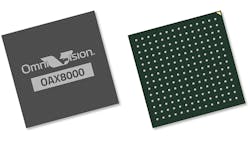Dedicated Driver-Monitoring System ASIC Eliminates External Circuitry
This article appeared in Microwaves & RF and has been published here with permission.
Driver-monitoring systems (DMSs) look to be a booming business in the next few years, thanks in part to EU requirements that all new vehicles sold in the region include a DMS camera by 2022. OmniVision Technologies is hoping to get a jump on competitors with its OAX8000, an AI-enabled, automotive ASIC optimized for entry-level, standalone driver-monitoring systems. The OAX8000 uses a stacked-die architecture to provide the industry’s only DMS processor with on-chip DDR3 SDRAM memory (1 GB).
The OAX8000 is also claimed to be the only dedicated DMS processor to integrate a neural processing unit (NPU) and image signal processor (ISP), which provides dedicated processing speeds up to 1.1 trillion operations per second for eye-gaze and eye-tracking algorithms. These high processing speeds with 1K MAC of convolutional neural network (CNN) acceleration, along with integrated SDRAM, enable the lowest power consumption available for DMS systems—the OAX8000 and OmniVision automotive image sensor consume just 1 W in typical conditions, combined. Further optimizing DMS systems, this integration also reduces the board area for the engine control unit (ECU).
Given that it is dedicated to DMS functionality, the OAX8000 sidesteps the need for added circuitry to perform DMS functions that consume more power, occupy more space, and do not allow for on-chip SDRAM.
The OAX8000’s on-chip NPU is supported by the popular TensorFlow, Caffe, MXNet, and ONNX tool chains. Additionally, this ASIC embeds quad Arm Cortex-A5 CPU cores with Neon technology for accelerated video encoding/decoding and on-chip video analytics algorithms, along with hardware for image processing, video encoding, and RGB/IR processing.
The device’s high-dynamic-range (HDR) processing capability allows the ASIC to accept input from RBG/IR image sensors and support high-quality output, for videos taken during the day or at night, in conditions with widely contrasting bright and dark images. The integrated video encoder accepts up to 5-Mpixel captures from OmniVision’s automotive image sensors, and outputs up to 2K resolution video at 30 frames/s.
Boot-up time for the OAX8000 is significantly faster than its nearest competitor. This rapid startup eliminates any delay between ignition and activation of the DMS camera. Furthermore, it supports secure-boot features to provide cybersecurity.
Other applications include processing occupant-detection algorithms, such as distinguishing a baby from a grocery bag, and providing alerts when objects are left behind in the vehicle. This ASIC also can be used in automotive video security systems to perform functions such as FaceID, as well as preset driver-comfort settings (e.g., seat position) that are activated when the DMS first scans the driver’s face.
Samples of the new OAX8000 ASIC are available now in a BGA196 package. It is AEC-Q100 Grade 2-certified for automotive applications.


